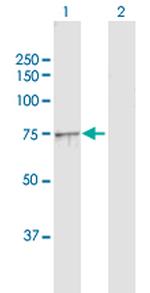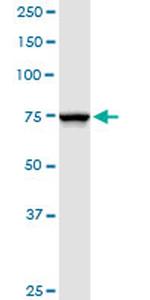Search Thermo Fisher Scientific
图: 1 / 3
NDUFS1 Antibody (H00004719-D01P) in WB
Lane 1: NDUFS1 transfected lysate(79.50 KDa).
Lane 2: Non-transfected lysate.



产品信息
H00004719-D01P
种属反应
宿主/亚型
分类
类型
抗原
偶联物
形式
浓度
纯化类型
保存液
内含物
保存条件
运输条件
产品详细信息
Sequence of this protein is as follows: MLRIPVRKAL VGLSKSPKGC VRTTATAASN LIEVFVDGQS VMVEPGTTVL QACEKVGMQI PRFCYHERLS VAGNCRMCLV EIEKAPKVVA ACAMPVMKGW NILTNSEKSK KAREGVMEFL LANHPLDCPI CDQGGECDLQ DQSMMFGNDR SRFLEGKRAV EDKNIGPLVK TIMTRCIQCT RCIRFASEIA GVDDLGTTGR GNDMQVGTYI EKMFMSELSG NIIDICPVGA LTSKPYAFTA RPWETRKTES IDVMDAVGSN IVVSTRTGEV MRILPRMHED INEEWISDKT RFAYDGLKRQ RLTEPMVRNE KGLLTYTSWE DALSRVAGML QSFQGKDVAA IAGGLVDAEA LVALKDLLNR VDSDTLCTEE VFPTAGAGTD LRSNYLLNTT IAGVEEADVV LLVGTNPRFE APLFNARIRK SWLHNDLKVA LIGSPVDLTY TYDHLGDSPK ILQDIASGSH PFSQVLKEAK KPMVVLGSSA LQRNDGAAIL AAVSSIAQKI RMTSGVTGDW KVMNILHRIA SQVAALDLGY KPGVEAIRKN PPKVLFLLGA DGGCITRQDL PKDCFIIYQG HHGDVGAPIA DVILPGAAYT EKSATYVNTE GRAQQTKVAV TPPGLAREDW KIIRALSEIA GMTLPYDTLD QVRNRLEEVS PNLVRYDDIE GANYFQQANE LSKLVNQQLL ADPLVPPQLT IKDFYMTDSI SRASQTMAKC VKAVTEGAQA VEEPSIC
靶标信息
The protein encoded by this gene belongs to the complex I 75 kDa subunit family. Mammalian complex I is composed of 45 different subunits. It locates at the mitochondrial inner membrane. This protein has NADH dehydrogenase activity and oxidoreductase activity. It transfers electrons from NADH to the respiratory chain. The immediate electron acceptor for the enzyme is believed to be ubiquinone. This protein is the largest subunit of complex I and it is a component of the iron-sulfur fragment of the enzyme. It may form part of the active site crevice where NADH is oxidized. Mutations in this gene are associated with complex I deficiency. Several transcript variants encoding different isoforms have been found for this gene.
仅用于科研。不用于诊断过程。未经明确授权不得转售。
篇参考文献 (0)
生物信息学
蛋白别名: CI-75kD; complex I 75kDa subunit; complex I, mitochondrial respiratory chain, 75-kD subunit; Complex I-75kD; MGC26839; mitochondrial NADH-ubiquinone oxidoreductase 75 kDa subunit; NADH dehydrogenase (ubiquinone) Fe-S protein 1, 75kDa (NADH-coenzyme Q reductase); NADH-ubiquinone oxidoreductase 75 kDa subunit, mitochondrial; NDUFS-1; OTTHUMP00000206345
基因别名: CI-75k; CI-75Kd; NDUFS1; PRO1304
UniProt ID: (Human) P28331
Entrez Gene ID: (Human) 4719



